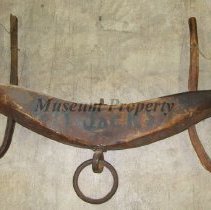Object Record
Images

Metadata
Object Name |
Yoke, Animal |
Source |
Cedar Falls Historical Society |
Iowa History Era Tag |
Statehood and the Civil War Era (1847-1868) |
Chronological Tag |
Expansion and Reform (1801-1861) |
Catalog Number |
2018.018.010 |
Credit line |
Cedar Falls Historical Society - Cedar Falls, Iowa |
Description |
This yoke was used to drive the team of oxen that brought William Sunderlin and his family to Iowa in 1856. This bow yoke is carved from a solid piece of wood and is quite heavy. The yoke sat on top of the animals' shoulders and the bentwood bows slid around the neck from the bottom and were secured with the ends poking out the top of the yoke, as is shown in the carved model. The iron ring at the center bottom of the yoke attached to a pole or chain from the wagon or plow. In this way, the oxen could push against the yoke with all their strength. The name of the donor's father, B. H. Jackson, is painted on the yoke. Content can be used with the following standards: 3rd grade SS 3.27 Immigration and Migration in a lesson on families' migration towards the West. For any use other than instructional resources, please check with the organization that owns this item regarding copyright restrictions. |
Notes on Related Objects |
Object is related to the following library resources, which can be found by searching the catalog number in the advanced search section: Catalog #: 2018.045.028 Crossroads on the Cedar: A Story of Two . Cities 2018.045.078- The Middle West in American History 2018.045.138- History of Iowa from the Earliest Times to the Beginning of the Twentieth Century 2018.045.184- Iowa: The Pioneer Heritage |
Primary/Secondary Source |
Significant - Local |
County Tag |
Black Hawk |
People |
Sunderlin, William |
Relation |
Show Related Records... |
Multimedia Links |
Click here to view/hear the file. |
Search Terms |
People Plants & Animals Early Transportation Ox teams Immigrants |
Legal Status |
Ownership of this resource is held by the Cedar Falls Historical Society and has been provided here for educational purposes only, specifically for use in the Iowa Museum Association's "Teaching Iowa History" project. It may not be downloaded, reproduced or distributed in any format without written permission from the Rights Holder. For information on U.S. and International copyright laws, consult an attorney. |
